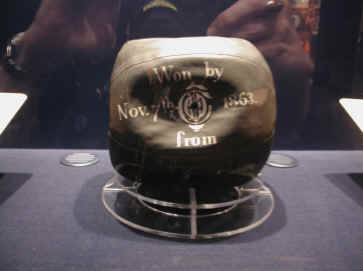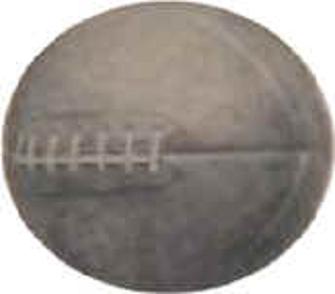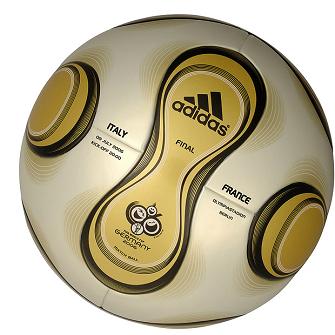Given the very modest origins of the football, it’s amazing to think about what a modern-day one can do. More often than not, we think and talk about the people using it, which is understandable.
Look at football as art. The footballer is the painter, his body is the paintbrush, the pitch is his expansive canvas, and the football is his paint. When prominent painters are discussed, most conversations are about them and their creations, not what they used to create their masterpieces.
Many people can stick a paintbrush in paint and throw it up on a canvas, but the amount of people who truly have the skill to make a masterpiece, to set minds and emotions in motions, is minimal, thus why the artist gets the plaudits and why great paintings are remembered as they are.
The analogy can go much deeper, but that’s another subject for another time. But in short, that’s why Lionel Messi and Cristiano Ronaldo are so revered, as they are masters of the art, and that’s why great goals are so celebrated, because they make people think and feel.
But the football can be looked at much the same way you look at an iPad/iPod/iPhone, a video game console, or a car, as technologically as footballs now are and how much they’ve evolved since the beginning, much like current automobiles, many of which come with a laundry list of features that would make Henry Ford’s head spin, is much different than the early models.
And though the conversation will naturally shift back in a flash to the artists, their talents, and their creations, it’s time for the tools to get some of the spotlight, to understand where they’ve come from, where they are now, and where they’re going.
History and Early Evolution of the Football
His surname might be more associated with the auto world, but the world of football has a lot to thank Charles Goodyear for.
Many early games that involved kicking some sort of an object were played with animal skins or bladders, and in some cases leather. Also, legend has it that some games were played with animal or human skulls! However, the common animal leather balls didn’t hold their shape well, weren’t easy to control, and couldn’t withstand the kind of beatings that footballs take now.
Then along came Goodyear, who discovered (accidentally, at that) and perfected the process of vulcanizing rubber. Vulcanization, which makes rubber stronger, more elastic, and more resistance to solvents, heat, and cold, really kick-started the evolution of the football.
In 1855, Goodyear created the first ball made from vulcanized rubber, and seven years later, H.J. Lindon went a step further by creating an inflatable rubber bladder, which made the ball easier to kick and allowed it to better maintain its shape.
As the ball became more developed and as the game of football became more developed, it was inevitable that standards for the balls would come about. And in 1872, the English FA decreed that the football must be spherical, have a circumference of no more than 27 to 28 inches, and weigh no more than 13 to 15 ounces.
To this day, the only deviation from those rules, which were adopted years later by FIFA, has been to change the maximum weight to 14 to 16 ounces.
Footballs in the 20th Century
By the turn of the 20th century, footballs had started to become mass produced by countries like Mitre (the current official ball supplier of the Scottish Premier League and The Football League), and by then, balls with rubber bladders were the norm. Balls at that time were stitched and paneled with heavy leather covers, and they were far easier to kick than previous balls.
However, heading the ball was painful and dangerous, in large part because water absorption during rain made the ball even heavier.
In time, the water absorption issues would be taken care of by using synthetic paints and other non-porous materials to coat the leather cover, and the laced slit that was once used for ball inflation was replaced by a valve.
Other changes would come as well. White balls were unofficially used as early as 1892, but they were officially permitted for use in 1951, to allow spectators to see the ball easier. Also in the 1950s, orange balls were introduced to allow the ball to be seen in the snow.
A Move to Synthetics
The first completely synthetic balls were made in the 1960s, but it’d be another couple of decades before synthetic balls fully replaced the leather ball. It’d been thought that leather balls were better for consistent bounce and flight, but synthetic balls have the same properties as the leather balls but with less water absorption.
Starting with the 1970 World Cup, the FIFA-approved ball design was based on the concepts of legendary American architect, author, and inventor R. Buckminster Fuller.
The ball featured a series of 20 hexagonal and 12 pentagonal synthetic leather panels that were sewn together to make a spherical surface, and it was used until the 2006 World Cup, when it was replaced by the 14-panel Adidas Teamgeist. The Adidas Jabulani, which was the match ball for the 2010 World Cup, features only eight panels.
The Who’s and How’s of Football Manufacturing
Nike and Adidas are the top two major players in the sporting goods industry, and they’re also the top dogs when it comes to football manufacturing.
The official balls for the English Premier League, Spain’s La Liga, and Italy’s Serie A are all made by Nike. Meanwhile, Adidas makes the official balls for Germany’s Bundesliga, UEFA’s major competitions (European Championships, UEFA Champions League, Europa League, and the Super Cup), and the FIFA World Cup.
As for major competitions who don’t use balls made by Nike or Adidas, as mentioned above, the Scottish Premier League and The Football League in England use Mitre balls, and Puma balls are used by France’s Ligue 1.
Present-day footballs are comprised of the surface, the stitching, the lining, and the bladder.
- Surface: The surface of the ball is made from synthetic leather, which is made from polyurethane and PVC. As mentioned, the surface is made of numerous panels, and it must be noted that balls with fewer panels generally curve more than other balls, as fewer panels mean a less stable cover.
- Stitching: Panels can be stitched, glued or thermally molded together. The primary method is stitching, which is often done with polyester thread. More expensive balls are stitched by hand, while other balls are stitched by a machine.
As for the other methods, gluing is used for cheaper balls, whereas thermal molding was used for the Adidas Jabulani and the Adidas Roteiro, which was the match ball for Euro 2004.
- Lining: Multiple layers of lining, which are made of polyester and/or cotton, are used to help the ball maintain its shape, strength, and bounce. Professional balls usually have four or more layers of lining, and many balls also use a foam layer for better cushioning and ball control.
- Bladder: Bladders are usually made with latex or butyl, while some manufacturers use bladders made of polyurethane. Latex bladders have better surface tension, a soft feel, and a better bounce. On the other hand, butyl bladders, which are found in most of the better balls out there, provide superior air retention.
As time passes, the world evolves, and technology evolves with it, and with that in mind, the future will see even more changes to the composition of the football, all for the purpose of maximizing what it can do but limiting its negatives at the same time. It’s safe to say that we’ve come a long way from bladders, skins, and skulls, haven’t we?
Add Sportslens to your Google News Feed!



